| HOME | CONSULTING | PUBLICATIONS | PROJECTS | CV (PDF) |
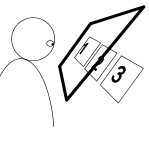 |
PARIS Study A User Study to Evaluate the Effectiveness of the PARIS Device |
The Personal Augmented Reality Immersive System (PARIS) is a device developed at the Electronic Visualization Laboratory that allows a user to interact with projected stereo graphics without ocluding their hand. This user study was designed to determine if the conpromises between egocentric horizon viewing and exocentric interaction with the hands was appropriate. The study found that, given the freedom to arrange their own interface, subjects prefered interactions requiring the minimum effort and that these interactions placed interface elements at the very edge of the viewable space.
|
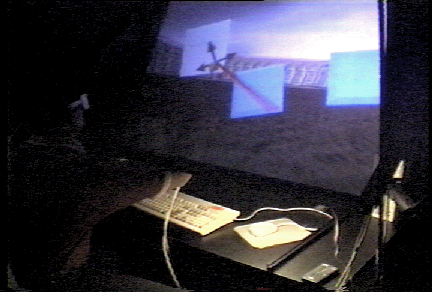 |
| Results When using a short virtual stick, subjects placed their interaction targets an average of only 12.33° degrees visually from the bottom extent of the PARIS viewing surface. By contrast, subjects placed their tragets at 23.31° above the screen bottom when using the longer stick. This supports a theory that as interactions move towards the hands, the natural working area moves towards the lower extreme of the viewing surface. Arguably, the PARIS design has compromised horizontal viewing (egocentric) and at-hand interaction (exocentric) in an attempt to accomodate both. |
 |
RELATED LINKS
The PARIS device at the Electronic Visualization Laboratory
MORE DETAILS
The sutdy consisted of 10 participants, 7 males and 3 females, of an average age of 24.3 years old all of whom have prior experience with tracked stereo display technology. There were two separate conditions, long and short virtual stick, in which the subject was required to strike a target numbered 1, 2 or 3. The time to strike each target was recorded along with a bit indicating if the correct target was selected. Before each set of two sets of 10 trails, subjects were given 5 minutes to arrange the targets and practice striking until comfortable. The average head position and final position of each of the three targets was collected by the system. The two conditions were alternated for each subject to avoid sequencing problems.
Statistical Results
The first two trials under each condition were thrown out to minimize practice effects. An repeated measures ANOVA on the remaining 8 trials indicated that there was no significant difference in time to strike targets with F1,8=2.092 and p=0.186 given the standard threshold of p=0.05. There was a significant difference in the error rates between both conditions with the long virtual stick producing more errors at F1,8=5.703 and p=0.041. The average position of the three target positions for each condition was compared with the average position of the head (figure above). A vector was generated from both head position average to target location and head position to the lower extent of the display device. The average angle between the lower bar and short stick targets was 12.33° while that for the long stick was 23.31°.
Discussion
The lack of a significant difference in target striking times indicates that users were able to position targets for each condition without introducing significant differences in task performance. The significant difference in error resulted from both the nature of the long stick condition and the location of the targets. The longer stick allowed users to keep their hands closer to their body and therefore encouraged a striking strategy involving angular changes in the wrist. This strategy appears to have motivated subjects to place targets closer in depth to their head resulting in the targets consuming a greater portion of the visual display. The result was that targets were somewhat more closely arranged than in the short stick condition and that the striking technique generated more situations where the virtual stick intersected the wrong target on the way towards the desired target. There are several good arguments for why the more direct interaction nature of the short stick is more accurate than that of the long stick. This study did not seek to quantify those differences, but it is worth noting that they contribute to the primary motivations for developing the PARIS device.
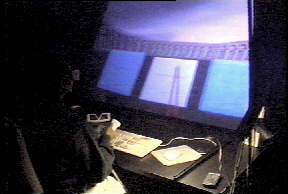 |
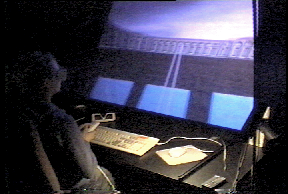 |
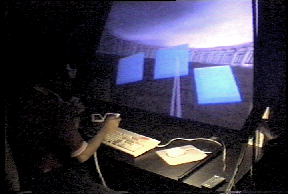 |
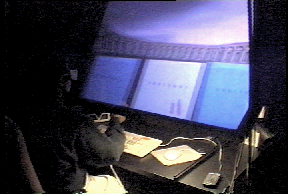 |
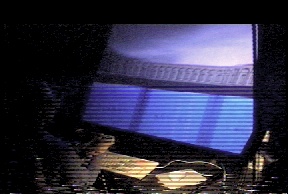 |
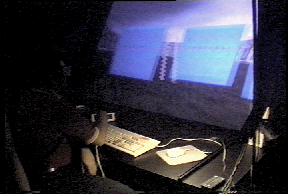 |
| For each of the three subjects above, the long stick condition is shown above the short stick condition. Each subject has been forced to reach further into the device when using the short virtual stick. This contributed to the first two subjects placing the targets as close to the lower visual extreme as possible. Also, note that the thrid subject is having to support his weight with his off arm in order to reach and strike targets not positioned near the lower visual extreme. | ||